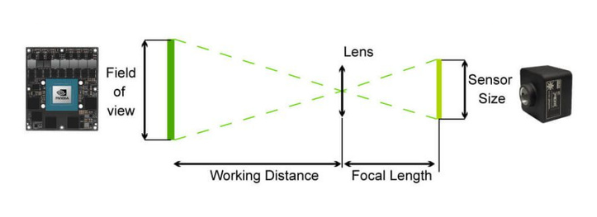What is Field of View (FOV) in imaging systems?
Published on: Aug 13, 2024

Written by: Admin
What is Field of View (FOV)?
Field of View (FOV) is the extent of the observable scene captured by an optical device, measured in degrees. It defines how much of the scene the camera or sensor captures horizontally and vertically.

How FOV is Determined
The FOV of a camera or imaging system is determined by several factors:
- Focal Length of the Lens:
- The focal length of the lens significantly affects the FOV. Shorter focal lengths provide a wider field of view, while longer focal lengths offer a narrower field of view.
- Wide-Angle Lens: Short focal length, wide FOV.
- Telephoto Lens: Long focal length, narrow FOV.
- Sensor Size:
- The size of the camera sensor also impacts the FOV. Larger sensors provide a wider field of view compared to smaller sensors with the same focal length lens.
- Lens Design:
- The optical design and construction of the lens influence the FOV, including factors such as the lens diameter and curvature.
Types of Field of View
- Horizontal Field of View (HFOV):
- The extent of the scene that can be captured horizontally.
- Vertical Field of View (VFOV):
- The extent of the scene that can be captured vertically.
- Diagonal Field of View (DFOV):
- The extent of the scene captured diagonally across the sensor.

Importance of FOV in Different Applications
- Photography and Videography:
- Wide FOV: Useful for landscape photography, architectural photography, and capturing large scenes.
- Narrow FOV: Ideal for portrait photography, wildlife photography, and capturing distant subjects.
- Surveillance:
- Wide FOV: Allows for monitoring large areas with a single camera, reducing the number of cameras needed.
- Narrow FOV: Suitable for focused monitoring of specific areas or objects.
- Machine Vision:
- Wide FOV: Useful for inspecting large objects or areas in industrial applications.
- Narrow FOV: Necessary for detailed inspection of small parts or components.
- Virtual Reality (VR) and Augmented Reality (AR):
- Wide FOV: Enhances immersion by providing a more extensive view of the virtual or augmented environment.
- Microscopy:
- Wide FOV: Useful for observing large specimens or areas of interest.
- Narrow FOV: Necessary for detailed examination of small regions.
Calculating FOV
The FOV can be calculated using the following formula:
FOV=2×arctan(d2f)\text{FOV} = 2 \times \arctan\left(\frac{d}{2f}\right)FOV=2×arctan(2fd)
where:
- ddd is the dimension of the sensor (horizontal, vertical, or diagonal).
- fff is the focal length of the lens.
Field of View (FOV) is a critical parameter in imaging systems that determines the extent of the observable scene captured by a camera or optical device. Understanding and selecting the appropriate FOV is essential for optimizing the performance and effectiveness of imaging applications in photography, surveillance, machine vision, VR/AR, and microscopy. The FOV is influenced by factors such as the focal length of the lens, sensor size, and lens design, and it plays a vital role in achieving the desired imaging results.

